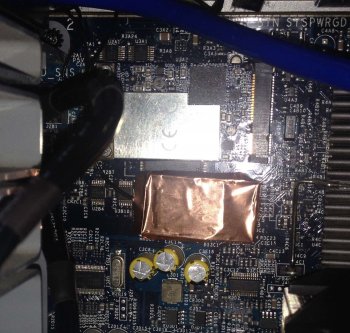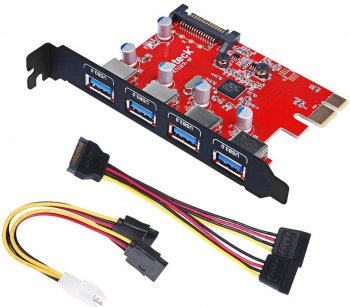PCIe cards that have a x4 physical connector may actually be only x2 electrical connection. This includes many or all of the ASM1142 cards. Some PCIe controllers do not allow x2, and will negotiate as x1 instead.
Slot 3 and 4 of the Mac Pro 2008 will negotiate any x2 card as x1. Those slots are PCIe 1.0, and at x1, they allow 250 MB/s. That's faster than an HDD but less than half the speed of an SSD. It's still much better than firewire or USB 2.0.
Slot 1 and 2 of the Mac Pro 2008 are PCIe 2.0 and will negotiate x2, so they will allow 1000 MB/s.
Any PCIe slot connected directly to a Sandy Bridge CPU (2nd Generation Core Processor Family Desktop CPU's) will not negotiate x2, and at PCIe 2.0, will allow up to 500 MB/s for x1. That's almost as fast as an SSD.
I would like to see a card that does PCIe 1.0 x4 so I can get the full performance of USB 3.1 on my old Mac Pro 2008 without using slot 1 (where the graphics card goes) or slot 2. For the ASM1142, the manufacturer would have to add a PCIe bridge chip to convert the PCIe 2.0 x2 of the ASM1142 to PCIe 1.0 x4 of the PCIe slot.
Two quick questions regarding the Caldigit 6GU3 Plus:
1) Has anyone had any further success at 10 Gbps? It's been a little while...
2) Are the two USB ports on independent controllers? I've searched the forums, but only see mention of the 6GU3 Pro having one USB controller between both ports...
Thanks!
S
I had been using a Startech 2-Port USB 3.1 (10Gbps) Card - 2x USB-C - PCIe (PEXUSB312C)
https://www.startech.com/ca/Cards-Adapters/USB-3.0/Cards/2-port-pcie-usb-3-1-card~PEXUSB312C
It is a PCIe gen2 x2 card using the ASM1142 ASMedia USB 3.1 Host Controller.
I have recently tried a Caldigit 6GU3 Plus. The layout is like this:
Code:
pci12d8,2308: PI7C9X2G308GP PCIe2 3-Port/8-Lane Packet Switch, GreenPacket™ Family
upstream port: 4 Lanes
downstream port 1: 2 Lanes
pci1b21,1242: ASM1142 ASMedia USB 3.1 Host Controller (2 ports)
downstream port 2: 2 Lanes
pci1b21,0625: ASM1062 ASMedia’s second generation Serial ATA Advantage HCI controller, two ports of Serial ATA 6GpsThe Caldigit uses the same USB controller but because there is a PCIe switch with 4 lanes upstream, the USB controller will have almost the same performance in my Mac Pro's gen 1 PCIe slot as the gen 2 PCIe slot (up to 1000 MB/s).
The Startech card can only operate up to 250 MB/s in my Mac Pro's gen 1 PCIe slot because that slot does not support x2 (even then it would only allow up to 500 MB/s).
Both USB ports (10 Gbps) are on the same USB controller, which uses a PCIe gen 2 x2 link so you can't raid them to get more than 1000 MB/s. The SATA ports (6 Gbps) have a similar limitation. You could raid the USB ports and the SATA ports together to get up to 2000 MB/s if the card is in a PCIe gen 2 slot.
The Caldigit card comes with USB 3.0 (5 Gbps) firmware so that it will be compatible with Mac OS X 10.11 (El Capitan) and earlier. I applied the USB 3.1 (10 Gbps) firmware updater from Caldigit's website which allows it to work only in macOS 10.12 (Sierra) or later but at 10 Gbps.
Both the Startech and the Caldigit cards show my OWC Mercury Elite Pro Dual mini bus-powered USB 3.1 Gen 2 RAID as "Up to 5 Gb/sec" but they both transfer at more than 5 Gb/sec (they read up to 745 MB/s in my Mac Pro 2008 and slightly faster in a Z170 Hackintosh), so this is probably a bug in the ASMedia firmware where it doesn't set the USB xHCI Port Status and Control Register (PORTSC) correctly (at least for this device). This register is read by Mac OS to display the current speed in System Information.app.
If you want a card with faster dual USB port support then it would need to use separate controllers or something like the ASM2142 which uses PCIe gen 3 x2. For a classic Mac Pro, that would need to be paired with at least a PCIe gen 3 2 port 6 lane switch.



